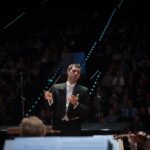The Role of a Principal Violist in an Orchestra
Introduction
The principal viola player, also known as the principal violist, holds a crucial role in an orchestra. While often overshadowed by the more prominent violin sections, the principal violist is a key player in shaping the overall sound and dynamics of the orchestra. In this article, we will explore the responsibilities and challenges that come with being a principal violist.
Responsibilities
As the principal violist, one of the primary responsibilities is to lead the viola section and ensure that all members are playing in unison. This involves setting the tone and pace of rehearsals, as well as providing guidance to other violists on phrasing, dynamics, and interpretation of the music.
The principal violist also plays a vital role in the overall sound of the orchestra. While the viola section may not always be featured prominently, their contributions are essential in creating a full, rich sound that complements the other sections of the orchestra.
In addition to leading the viola section, the principal violist often works closely with the conductor and other principal players to ensure that the orchestra is performing at its best. This involves collaborating on interpretations of the music, discussing bowings, and making decisions on other musical details that will shape the overall performance.
Challenges
Being a principal violist comes with its own set of challenges. One of the main difficulties is the pressure of leading a section of skilled musicians while also meeting the high standards set by the conductor and the rest of the orchestra. This requires not only technical proficiency but also strong leadership and communication skills.
Another challenge for principal violists is the repertoire. The viola has a rich and diverse repertoire, but it is often overshadowed by the more well-known violin and cello pieces. This means that principal violists must work extra hard to master their instrument and be able to perform at the same level as their colleagues in the violin and cello sections.
Additionally, the viola is often called upon to play important supporting roles in the orchestra, such as providing harmonic support or filling out the middle voices. This can be challenging for principal violists, as they must be able to seamlessly transition between supporting roles and taking on more prominent solos when required.
Skills and Qualities
To excel as a principal violist, certain skills and qualities are essential. Technical proficiency is of course important, as the viola is a challenging instrument to master. Principal violists must have a strong command of their instrument, including a solid understanding of technique, intonation, and tone production.
Leadership skills are also crucial for principal violists, as they must be able to guide and inspire their section while also working collaboratively with the rest of the orchestra. Effective communication is key, as principal violists must be able to convey their musical ideas to other musicians and work together to achieve a unified performance.
In addition to technical and leadership skills, principal violists must also possess a deep musical understanding and sensitivity. This includes an ability to interpret the music creatively, make informed musical decisions, and convey the emotion and nuance of the music to the audience.
Conclusion
In conclusion, the role of a principal violist in an orchestra is a challenging and rewarding one. From leading the viola section to collaborating with other musicians and shaping the overall sound of the orchestra, principal violists play a vital role in creating memorable performances.
With their technical proficiency, leadership skills, and musical sensitivity, principal violists bring a unique perspective to the orchestra and help to elevate the quality of the music. Whether supporting the other sections or taking on a solo role, the principal violist is a versatile and indispensable member of the orchestra.


